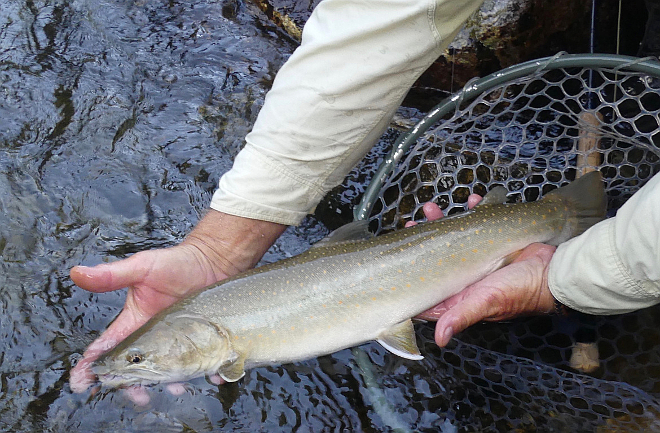|
Casting for the bulls: fishing for Idaho's bull
trout |
|
July 21, 2017 |
 |
By Roger Phillips
IDFG Public Information Specialist
They’re big, they’re hard fighting, and they’re
one of Idaho’s most overlooked trophy fishing
opportunities, but many anglers are still
confused whether they can target bull trout for
catch-and-release fishing.
The short answer is yes.
When bull trout were listed as threatened under
the federal Endangered Species Act in 1998, the
U.S. Fish and Wildlife Service determined state
fishing regulations provided sufficient
conservation benefits. In Idaho, that meant bull
trout fishing was allowed, but harvest was not.
Those regulations are still in place, so bull
trout can be caught, but they must be
immediately released unharmed. While they’re not
as abundant as other types of trout, Idaho’s
bull trout populations are generally in good
shape and capable of supporting some great
catch-and-release fishing opportunities.
Though you can’t take them home, fishing for
bull trout can be exciting because they’re large
fish and aggressive by nature, and they can be
caught on flies, lures and bait, if the body of
water is open to bait fishing.
Bull trout are widespread in Idaho, mostly in
rivers and streams, but they can also found in
lakes and reservoirs. They are in most river
drainages in central and northern Idaho that
flow into the Snake and Columbia rivers. They’re
most common in coldwater rivers, which in summer
often means upper-elevation streams. Bull trout
need water that’s 60 degrees or cooler, and
water that’s around 54 degrees is ideal habitat
for them.
Many bull trout will seasonally migrate through
watersheds. Some will winter in a large river,
or lake or reservoir, then move into tributaries
and headwaters during summer. They spawn in
early fall and then slowly migrate downstream to
complete the cycle. In some systems, this round
trip can be 50 miles or more.
Because of their migratory nature, bull trout
can be a challenge to locate, but if you know
their seasonal patterns, especially as they move
into the high country during summer, they can
congregate in relatively small streams.
When young, bull trout eat insects, but as they
grow larger, they shift their diet to other
fish. Bull trout evolved with whitefish,
sculpins and other trout, and consume them as
food.
How large a bull trout grows depends on where
they live and how much food is available, but
even in relatively small streams, they can dwarf
other resident trout species. The state-record
bull trout is 32 pounds, which was caught in
1949 from Lake Pend Oreille when harvest was
legal. The current state record for
catch-and-release is 23.5 inches from the Salmon
River.
Bull trout’s relatively large size and the water
clarity where they often reside means anglers
can spot them in holding water. But they’re
remarkably well camouflaged and become almost
invisible, even in shallow, clear water. You can
often spot the white tips of their fins, and the
shadow of a large fish might give away its
location.
Anglers targeting bull trout should focus on
their predatory nature by using lures or
streamer flies that imitate their prey,
especially imitating a wounded fish that makes
an easy meal.
Anglers targeting bull trout shouldn’t expect
high catch rates. The fish are often solitary
and well dispersed throughout the river systems,
but they can occasionally be found in small
schools.
While landing one can be a challenge, their size
and weight can sometimes rival salmon and
steelhead, and catching a large bull trout in
one of Idaho’s cool, clear mountain streams can
be an unforgettable experience.
Catch and release tips
* If possible, don't play the fish to total
exhaustion while attempting to land it.
* Keep the fish in the water as much as possible
when handling it, removing the hook and
preparing it for release.
* When removing the hook, don't squeeze the fish
or place your fingers in its gills.
* If the fish has swallowed the hook, don't pull
it out. Instead, cut the line as close to the
hook as possible, leaving the hook inside the
fish.
* If a fish is exhausted, hold it in a swimming
position in the water and gently move it back
and forth until it is able to swim away. |
|
Questions or comments about this
article?
Click here to e-mail! |
|
|
|
|

